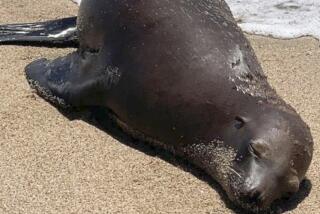Animal rescue workers looking for sea lion shooters in L.A. County
Marine animal rescue workers asked for help Tuesday to track down those responsible for a spate of sea lion shootings along the Los Angeles County coastline.
At least five sea lions have been found with bullet wounds at area beaches since December, said David Bard, operations director for the Marine Mammal Care Center at Fort MacArthur, a rehabilitation center in San Pedro. Two of them survived, but the rest had to be euthanized, he said.
It is illegal to use lethal force against California sea lions, which are protected under the Marine Mammal Protection Act, said Joe Cordaro, a wildlife biologist at the National Oceanic and Atmospheric Administration’s National Marine Fisheries Service. He said fishermen were probably to blame for the shootings.
“The sea lion population has been increasing over the years, and they do target both commercial and recreational fishermen and their catches,” he said. “Some fishermen take offense at the animals destroying their catches, so they try to prevent that by shooting to kill.”
The latest victim was a 9-month-old pup found Feb. 3 at Dockweiler Beach in Santa Monica Bay, said Peter Wallerstein, founding director of Marine Animal Rescue in El Segundo. Wallerstein’s group received a call about the animal from a concerned beachgoer.
“When we arrived on scene we saw this little 30-pound, 9-month-old sea lion pup lying on the beach,” Wallerstein said. At first glance, the animal appeared healthy. “Then he started dragging his back end like he couldn’t move it,” Wallerstein said. “I was hoping it wasn’t what I thought it was.”
A radiograph confirmed that a bullet had severed the pup’s spine and he had to be euthanized, Wallerstein said.
An adult female and a yearling are recovering at the rehabilitation center in San Pedro. The yearling was stranded in Malibu after it was shot in the lung in December and is improving, Bard said. The adult was found last month near Hermosa Beach with a bullet in the shoulder, and her condition is “guarded,” he said.
The animal rescue and rehabilitation groups are working with the national fisheries’ law enforcement division to find the shooters, but Cordaro said it was hard to make a case without witnesses. As an added incentive, Marine Animal Rescue is offering a $5,000 reward for information leading to a conviction.
Wallerstein said the five latest victims were probably “just the tip of the iceberg.”
“These are the ones that make it to the beach. Can you imagine how many don’t make it?” he said.
Cordaro concurred. He said competition has been increasing between fishermen and the California sea lion population, which breeds on the Channel Islands and has grown to nearly 300,000.
Although there are a number of nonlethal methods that fishermen can use to protect their catches, Cordaro said they are often not effective. They include “seal bombs,” a firecracker-like device that makes an underwater bang. The noise is supposed to frighten the animals away, but they soon come back, Cordaro said.
Some fishermen are now hiding the devices in food, which they feed to the sea lions and they explode in their faces, Wallerstein said.
“We don’t believe this is something that we should tolerate as human beings,” he said. “If we don’t catch them, we hope that at least the shootings will stop.”
To report a violation, contact the NOAA Fisheries Enforcement Hotline at 800-853-1964.
--
More to Read
Sign up for Essential California
The most important California stories and recommendations in your inbox every morning.
You may occasionally receive promotional content from the Los Angeles Times.










